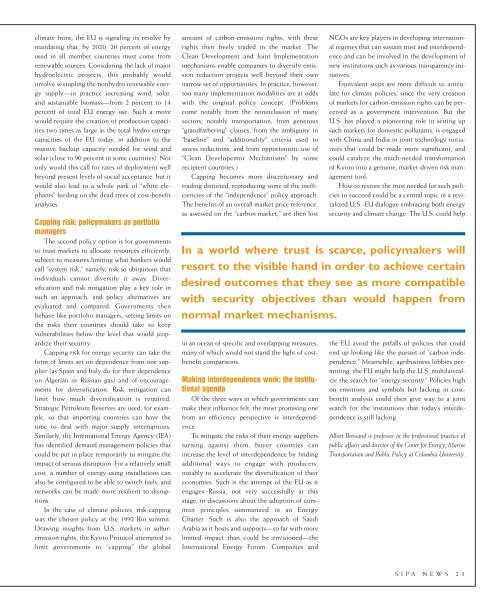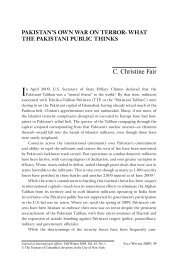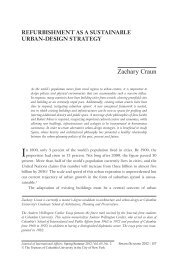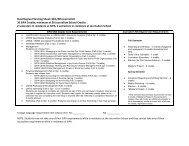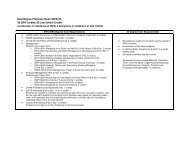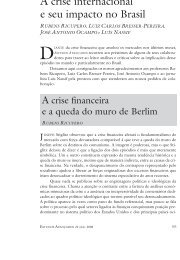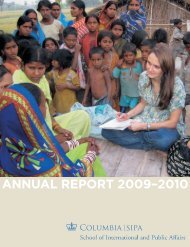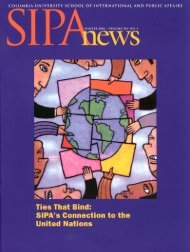The Energy Issue - School of International and Public Affairs ...
The Energy Issue - School of International and Public Affairs ...
The Energy Issue - School of International and Public Affairs ...
Create successful ePaper yourself
Turn your PDF publications into a flip-book with our unique Google optimized e-Paper software.
climate front, the EU is signaling its resolve by<br />
m<strong>and</strong>ating that, by 2020, 20 percent <strong>of</strong> energy<br />
used in all member countries must come from<br />
renewable sources. Considering the lack <strong>of</strong> major<br />
hydroelectric projects, this probably would<br />
involve sextupling the nonhydro renewable energy<br />
supply—in practice increasing wind, solar,<br />
<strong>and</strong> sustainable biomass—from 2 percent to 14<br />
percent <strong>of</strong> total EU energy use. Such a move<br />
would require the creation <strong>of</strong> production capacities<br />
two times as large as the total hydro energy<br />
capacities <strong>of</strong> the EU today, in addition to the<br />
massive backup capacity needed for wind <strong>and</strong><br />
solar (close to 90 percent in some countries). Not<br />
only would this call for rates <strong>of</strong> deployment well<br />
beyond present levels <strong>of</strong> social acceptance, but it<br />
would also lead to a whole park <strong>of</strong> “white elephants”<br />
feeding on the dead trees <strong>of</strong> cost-benefit<br />
analyses.<br />
Capping risk: policymakers as portfolio<br />
managers<br />
<strong>The</strong> second policy option is for governments<br />
to trust markets to allocate resources efficiently,<br />
subject to measures limiting what bankers would<br />
call “system risk,” namely, risk so ubiquitous that<br />
individuals cannot diversify it away. Diversification<br />
<strong>and</strong> risk mitigation play a key role in<br />
such an approach, <strong>and</strong> policy alternatives are<br />
evaluated <strong>and</strong> compared. Governments then<br />
behave like portfolio managers, setting limits on<br />
the risks their countries should take to keep<br />
vulnerabilities below the level that would jeopardize<br />
their security.<br />
Capping risk for energy security can take the<br />
form <strong>of</strong> limits set on dependence from one supplier<br />
(as Spain <strong>and</strong> Italy do for their dependence<br />
on Algerian or Russian gas) <strong>and</strong> <strong>of</strong> encouragements<br />
for diversification. Risk mitigation can<br />
limit how much diversification is required.<br />
Strategic Petroleum Reserves are used, for example,<br />
so that importing countries can have the<br />
time to deal with major supply interruptions.<br />
Similarly, the <strong>International</strong> <strong>Energy</strong> Agency (IEA)<br />
has identified dem<strong>and</strong> management policies that<br />
could be put in place temporarily to mitigate the<br />
impact <strong>of</strong> serious disruption. For a relatively small<br />
cost, a number <strong>of</strong> energy-using installations can<br />
also be configured to be able to switch fuels, <strong>and</strong><br />
networks can be made more resilient to disruptions.<br />
In the case <strong>of</strong> climate policies, risk-capping<br />
was the chosen policy at the 1992 Rio summit.<br />
Drawing insights from U.S. markets in sulfuremission<br />
rights, the Kyoto Protocol attempted to<br />
limit governments to “capping” the global<br />
amount <strong>of</strong> carbon-emissions rights, with these<br />
rights then freely traded in the market. <strong>The</strong><br />
Clean Development <strong>and</strong> Joint Implementation<br />
mechanisms enable companies to diversify emission<br />
reduction projects well beyond their own<br />
narrow set <strong>of</strong> opportunities. In practice, however,<br />
too many implementation modalities are at odds<br />
with the original policy concept. (Problems<br />
come notably from the noninclusion <strong>of</strong> many<br />
sectors, notably transportation, from generous<br />
“gr<strong>and</strong>fathering” clauses, from the ambiguity in<br />
“baseline” <strong>and</strong> “additionality” criteria used to<br />
assess reductions, <strong>and</strong> from opportunistic use <strong>of</strong><br />
“Clean Developemnt Mechanisms” by some<br />
recipient countries.)<br />
Capping becomes more discretionary <strong>and</strong><br />
trading distorted, reproducing some <strong>of</strong> the inefficiencies<br />
<strong>of</strong> the “independence” policy approach.<br />
<strong>The</strong> benefits <strong>of</strong> an overall market price reference,<br />
as assessed on the “carbon market,” are then lost<br />
in an ocean <strong>of</strong> specific <strong>and</strong> overlapping measures,<br />
many <strong>of</strong> which would not st<strong>and</strong> the light <strong>of</strong> costbenefit<br />
comparisons.<br />
Making interdependence work: the institutional<br />
agenda<br />
Of the three ways in which governments can<br />
make their influence felt, the most promising one<br />
from an efficiency perspective is interdependence.<br />
To mitigate the risks <strong>of</strong> their energy suppliers<br />
turning against them, buyer countries can<br />
increase the level <strong>of</strong> interdependence by finding<br />
additional ways to engage with producers,<br />
notably to accelerate the diversification <strong>of</strong> their<br />
economies. Such is the attempt <strong>of</strong> the EU as it<br />
engages Russia, not very successfully at this<br />
stage, in discussions about the adoption <strong>of</strong> common<br />
principles summarized in an <strong>Energy</strong><br />
Charter. Such is also the approach <strong>of</strong> Saudi<br />
Arabia as it hosts <strong>and</strong> supports—so far with more<br />
limited impact than could be envisioned—the<br />
<strong>International</strong> <strong>Energy</strong> Forum. Companies <strong>and</strong><br />
NGOs are key players in developing international<br />
regimes that can sustain trust <strong>and</strong> interdependence<br />
<strong>and</strong> can be involved in the development <strong>of</strong><br />
new institutions such as various transparency initiatives.<br />
Equivalent steps are more difficult to articulate<br />
for climate policies, since the very creation<br />
<strong>of</strong> markets for carbon-emission rights can be perceived<br />
as a government intervention. But the<br />
U.S. has played a pioneering role in setting up<br />
such markets for domestic pollutants, is engaged<br />
with China <strong>and</strong> India in joint technology initiatives<br />
that could be made more significant, <strong>and</strong><br />
could catalyze the much-needed transformation<br />
<strong>of</strong> Kyoto into a genuine, market-driven risk management<br />
tool.<br />
How to restore the trust needed for such policies<br />
to succeed could be a central topic in a revitalized<br />
U.S.-EU dialogue embracing both energy<br />
security <strong>and</strong> climate change. <strong>The</strong> U.S. could help<br />
In a world where trust is scarce, policymakers will<br />
resort to the visible h<strong>and</strong> in order to achieve certain<br />
desired outcomes that they see as more compatible<br />
with security objectives than would happen from<br />
normal market mechanisms.<br />
the EU avoid the pitfalls <strong>of</strong> policies that could<br />
end up looking like the pursuit <strong>of</strong> “carbon independence.”<br />
Meanwhile, agribusiness lobbies permitting,<br />
the EU might help the U.S. multilateralize<br />
the search for “energy security.” Policies high<br />
on emotions <strong>and</strong> symbols but lacking in costbenefit<br />
analysis could then give way to a joint<br />
search for the institutions that today’s interdependence<br />
is still lacking.<br />
Albert Bress<strong>and</strong> is pr<strong>of</strong>essor in the pr<strong>of</strong>essional practice <strong>of</strong><br />
public affairs <strong>and</strong> director <strong>of</strong> the Center for <strong>Energy</strong>, Marine<br />
Transportation <strong>and</strong> <strong>Public</strong> Policy at Columbia University.<br />
SIPA NEWS 23


